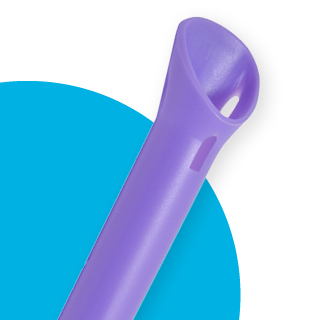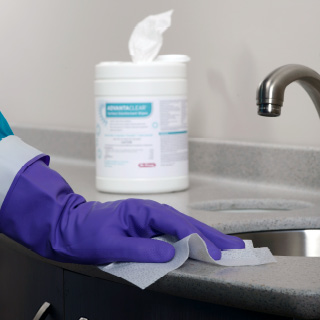Blog
Four Changes to Infection Prevention and Control that Made a Difference

Revisiting Critical Updates That Address Infection Risks
At this time last year, we were all collectively reeling from the onset of the COVID-19 pandemic and dealing with the confusion, uncertainty, and anxiety of managing a new virus. And, in the midst of an unprecedented shutdown that nearly ground dentistry to a complete halt, practices pivoted on the fly to implement new infection prevention and control procedures that would enable them to continue practicing safely.
The past year has not been easy, to say the least. But the good news is that the Herculean effort that dental professionals put in to improve infection prevention and control seems to have paid off. In a recent study conducted by the American Dental Association (ADA) and the American Dental Hygienist Association (ADHA), researchers found that only 3.1% of surveyed dental hygienists had ever tested positive or been diagnosed with COVID-19 as of October 2020, despite being a high-risk group.
Additionally, the development and distribution of effective vaccines has already had a positive impact on the industry, with dental professionals receiving vaccinations at high rates. Recently, DrBicuspid surveyed their membership and reported that, “Nearly 80% of dental professionals have received at least one shot of the COVID-19 vaccine.”
As infection rates among hygienists remain low and vaccination rates continue to rise, we may be turning a corner with the virus. But, if there is one lasting lesson from the last year, it’s that the risk of infections is ever-present, and infection prevention and control will remain a critical issue indefinitely.
Dental professionals have gone above-and-beyond to address infection risks and keep their practices safe. Here are four critical changes that practices made (and should continue to make) in order to keep up the good work:
- Stringent Personal Protective Equipment (PPE) Use
Perhaps the most critical action practices took was adopting more stringent PPE standards. While PPE has always been a major part of the dental experience, the pandemic necessitated the universal implementation of PPE for everyone in the practice – patients and staff alike – regardless of whether they exhibited symptoms of the pandemic.
Additionally, dental professionals have adopted the use of face masks and respirators with higher levels of protection. The use of ASTM Level 3 masks or N95 respirators – particularly in areas with moderate to substantial community spread – has become far more commonplace, and the CDC recommends the use of N95 respirators for any aerosol generating procedures.
While demand at the start of the pandemic necessitated some temporary optimization strategies, PPE supply is now widely available, so dental professionals should continue to follow all CDC best practices and OSHA standards when it comes to its usage. This applies to respirator fit testing as well. Fit testing continues to be a requirement for healthcare professionals that use respirators. This critical step helps protect staff and patients by making sure the N95 respirators are functioning properly for the user.
- Improved Aerosol Management Practices
 As we learned more about the coronavirus and how it spreads through aerosol droplets, dental professionals had to rethink the use of aerosol-generating equipment and procedures. Many state dental boards temporarily suspended these types of procedures, and the CDC and ADHA advise dental practices to avoid aerosol-generating procedures whenever possible. The agency also provided precautions to minimize droplet spatter and aerosols when such procedures were necessary and when patients showed no signs of coronavirus infection.
As we learned more about the coronavirus and how it spreads through aerosol droplets, dental professionals had to rethink the use of aerosol-generating equipment and procedures. Many state dental boards temporarily suspended these types of procedures, and the CDC and ADHA advise dental practices to avoid aerosol-generating procedures whenever possible. The agency also provided precautions to minimize droplet spatter and aerosols when such procedures were necessary and when patients showed no signs of coronavirus infection.
By revisiting aerosol management and HVE best practices, dental practitioners were able to adopt strategies like four-handed dentistry and adjusting the power levels on ultrasonic scalers to continue practicing safely.
And by adding high volume evacuation (HVE) as a standard protocol, practitioners were able to better mitigate aerosols generated during procedures. Products such as the HVEsolo™ Disposable Evacuation Tips reduce aerosol contamination by more than 90% and are useable with traditional two-handed dentistry.
Additionally, many practitioners began using hand instrumentation with more frequency to avoid generating aerosols in the first place. New instrumentation like the Harmony™ Ergonomic Scalers and Curettes minimize strain, fatigue and risk of injury to clinicians by reducing the pinch force in clinicians’ hands and pressure needed on the tooth, which may alleviate conditions caused by repetitive motions.
- Better Engineering and Administrative Controls
In the NIOSH-defined Hierarchy of Controls, PPE is actually the last line of defense for protecting workers. Before PPE comes engineering and administrative controls (in addition to elimination and substitution strategies), which dental professionals successfully implemented in their practice. This included actions like re-arranging the practice space – including waiting room and operatory – to ensure the ability to physical distance and moving or removing unnecessary items like periodicals. Practices also successfully implemented new check-in procedures to limit the number of patients in the physical space at any given time. Additionally, screening and triage protocols helped ensure that potentially sick or infected patients could be identified and asked to reschedule prior to their appointments, while teledentistry provided new options for treatment.
- Enhanced Preparedness
 Although the last year has been challenging, dental professionals (and patients) are far more aware of infection prevention and control best practices than ever before. Traditionally, staying ahead of infection prevention and control guidelines has not been easy, and the rapid introduction of interim guidance only added to the challenge. But dental professionals rose to the occasion and are more prepared than ever to deal with the next challenge that comes their way.
Although the last year has been challenging, dental professionals (and patients) are far more aware of infection prevention and control best practices than ever before. Traditionally, staying ahead of infection prevention and control guidelines has not been easy, and the rapid introduction of interim guidance only added to the challenge. But dental professionals rose to the occasion and are more prepared than ever to deal with the next challenge that comes their way.
Whether its instrument reprocessing and sterilization, waterline maintenance, hand hygiene, clinical techniques, or any other element of daily practice, infection prevention and control is a constant variable that requires attention.
Through the crucible of the pandemic, dental professionals have persevered to prioritize their safety and their patients’ safety. Ultimately, that preparedness and attention to detail will only serve as a benefit in the long run.
All company and product names are trademarks of Hu-Friedy Mfg. Co., LLC, its affiliates or related companies, unless otherwise noted.
